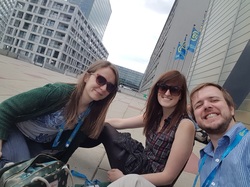 Enjoying the lunch break with flatmates. Enjoying the lunch break with flatmates. As those will have ever attended EGU will testify - it is very very expensive. This year, I was only partially funded by my department (many thanks to them for the money that was provided!), so I tried in earnest to keep costs down. So here are a number of hopefully helpful tips:
I hope these will be of help to someone! 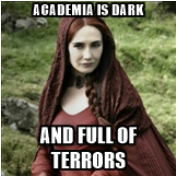 The long awaited follow-up to "What if your supervisor was from Lord of the Rings", conveniently timed for the first episode of Season 6: Game of Thrones Academics. Professor Ned Stark - Possibly the most popular member of staff in the department. Specialises in the study of wolves and winter migration. However, is so bad with internal politics that when he upsets the balance of power he gets sacked. Academic Rating: 7/10. Dr. Jon Snow - The youngest ever Head of Department, remarkably talented for his age. Over-estimates his ability to lead those many times his own age. Ends up leaving the academic career path abruptly. Followed in his Uncles footsteps studying the physics of large ice masses. Academic Rating: 5/10. Dr. Melisandre - Not who she appears to be. A bit of a pyromaniac who loves studying fire, but may not be as good as she thinks she is. Liable to move around from University to University at will. Academic Rating: 4/10. Dr. Tyrion Lannister - Don't let his size deceive you. Tyrion is perhaps the most intelligent scientist in the department, however, he prefers to spend his time drinking than actually working. A Historian presently working overseas. Academic Rating: 5/10. Dr. Jaime Lannister (The Kingslayer) - Very good at his job and experienced when conducting field work. An unfortunate accident meant that he got lost in the field for a few years. Has no desire to advance his position. Academic Rating: 8/10. Professor Cersei Lannister - A social scientist with lots of money, tends not to actually do any work, preferring to delegate to minions. Ideas are often deluded. Academic Rating: 4/10. Littlefinger - Works in an independent institution. His work is so clouded in mystery that no one is really sure of his true qualifications or what he actually studies. Has never been known to collaborate fully with anyone - liable to steal your work. Has dreams of becoming Pro Vice-Chancellor. Academic Rating: 3/10. Dr. Davos Seaworth (The Onion Knight) - Didn't ever get round to completing an undergraduate degree, so struggled to gain the respect of his colleagues when awarded his PhD. But after many years has proven himself a worthy and fair academic. Specialises in the study of advanced farming techniques. Academic Rating: 9/10. Arya Stark - A Masters student who has a promising future if we she would follow the advice of her elders. Has shown an interest in advanced cosmetic surgery from an early stage. Academic Rating: 8/10. Dr. Daenerys Targaryen - Recently graduated PhD student who has delusions of grandeur. Specialises in political science. Has experience collaborating across a number of sectors. Has already sent ripples throughout the academic world championing Open Access science. Has a gift for languages which is highly valuable. Academic Rating: 8/10. Disclaimer: The above descriptions are fictional. It is meant an amusing and general look at academic life which should not be taken seriously. Any resemblance to real people is a huge huge huge coincidence. 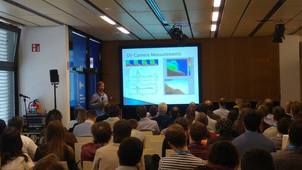 Taken by John Browning Taken by John Browning Two days of fantastic volcanic science. This year was the year of 3D science. From investigating bubble distribution in rocks through to models of lava flows - three dimensions were being used to their full effect. This was also the busiest EGU I have been to, either that or the volcanic sessions are becoming more popular! Seats were hard to come by unless you were arrived early to sessions - this meant a sprawl of scientists leaning against walls and perched on the floor! Monday started with "Magma ascent, degassing, and eruption dynamics" where a number interesting talks set my conference off at a good pace. Matthias Hort discussed the use of doppler radar to estimate the length of bursting bubbles at volcanoes such as Stromboli and Yasur - an interesting alternative to traditional gas measurements, using seismicity or even infrasound. The session continued with a look at patterns in lava lakes, from the intriguing plate tectonics displayed at Kilauea and Erta Ale, to the turbulence surface at Marum and the relative stability at Erebus. Patrick Allard finished off the morning pre-coffee break session with a very thorough and interesting discussion, investigating a range of results from Ambrym volcano and the Marum and Benbow lava lakes, including a relatively thorough look at degassing in a bid to understand aspects such as magma ascent rate and the depth and volume of storage bodies. I finished the day listening to a range of talks on atmospheric emissions from voclanoes. Tuesday was the turn of "Volcanic Gas Emissions" where a number of presentations ranging from soil degassing on Stromboli to oscillating ratios of Bromine Oxide to Sulphur Dioxide on Cotopaxi which may be related to Earth tides. Of course this was also the session I presented in (see right). See picture above. I decided to finish the main section of the Tuesday afternoon talks in a session dedicated to Planetary Sciences. In particular I was interested in talk on the geology of Pluto and Charon - with features created from the varying behaviours of Nitrogen and Water ice. In addition the presenter gave his two cents on the possible volcanoes, Wright Mons and Piccard Mons. This year was the first time I ventured to the ice breaker on the Sunday evening and I would highly recommend that others do the same, it was a great chance to meet up with friends and colleagues. The days of the conference can be very busy and it is often difficult to meet up with all the people you want to. I came home on the Wednesday to play in the University of Sheffield varsity ice hockey match, making my EGU trip shorter than usual! 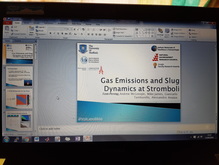 Another year, and another EGU, my third so far. Again, I am looking forward to a couple of days of sciencey goodness. This year I am trying to do EGU on a budget, which is not an easy task! Perhaps I shall blog a few tips afterwards. I shall be attending volcanic sessions on Monday and Tuesday and will blog about some of the fascinating science that is presented during oral sessions and posters. Looking forward to seeing new and familiar faces! I will be presenting on "Gas Emissions and Slug Dynamics" on Tuesday at 11 am. I will be talking about work conducted comparing UV camera measurements of a large number of events at Stromboli and computational simulations of slug flow. My abstract is below: Abstract: We present UV camera data for 200 strombolian and hornito degassing events at Stromboli during June and July 2014. This data was processed to calculate SO2 masses for each event. In addition to calculating SO2 masses of the slugs which generate these events we also observe periods of elevated flux following events, termed the gas coda, lasting ≈ 30 – 180 s, which we also calculate SO2masses for. This provided a range of explosive plus coda SO2 masses of ≈ 18 – 225 kg. In combination with 3D fluid numerical simulations of slug flow we begin to probe a possible generation mechanism for the observed gas codas. The simulations show that ‘daughter bubbles’ are produced from the base of ascending slugs, which result in gas mass loss rates from the slugs of between ≈ 1.2 – 14.2 kg s−1 . Nf , the dimensionless inverse viscosity number, can be used to characterise the form of a slug wake, and hence when mass loss through daughter bubble production may occur. However, the observed daughter bubble behaviour occurs at lower levels of Nf than predicted by previous mm- to cm-scale studies and suggests that extra physics (e.g. surface tension), beyond that included in Nf , may be needed to parameterise daughter bubble production. We suggest that daughter bubbles could play a role in modulating explosivity of strombolian eruptions as a potential causal mechanism for gas coda production.
|
Archives
July 2023
|
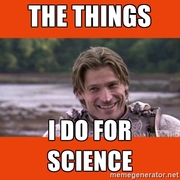

 RSS Feed
RSS Feed